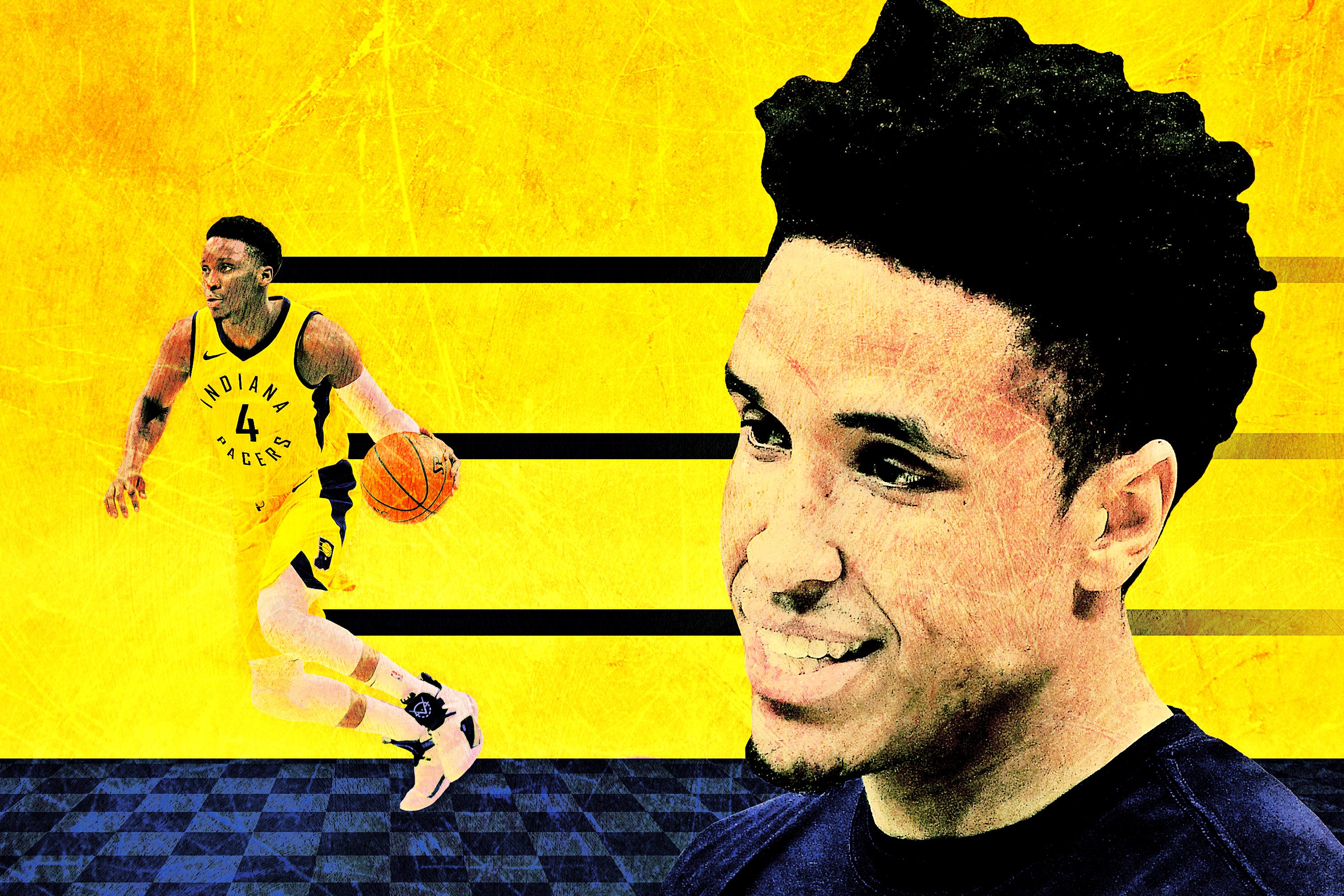
The Pacers have exceeded expectations ever since trading Paul George two summers ago. Instead of rebuilding after losing their franchise player, they found a new one in the deal, Victor Oladipo, and built a solid playoff team around him. The problem was that the success they’ve had over the past two seasons wasn’t sustainable over the long haul. The timetables of Oladipo and many of the key pieces around him didn’t align: Oladipo turned 27 in May, but he was playing with a bunch of veterans. Some of Oladipo’s best teammates were going to start declining just as he was entering his prime.
Five of Indiana’s top eight players—all of whom were older than Oladipo—entered free agency this year. But rather than bring back the same core, the Pacers have reshaped their team this offseason. All five free agents are gone, and they were all replaced by players younger than Oladipo. Now, the All-Star guard has a supporting cast that can grow with him once he gets healthy.
The difference between last season and this season in age of their key rotation players is striking:
2018-19
PG: Darren Collison (31), Cory Joseph (27)
SG: Victor Oladipo (26), Tyreke Evans (29)
SF: Bojan Bogdanovic (29)
PF: Thaddeus Young (30)
C: Myles Turner (22), Domantas Sabonis (22)
2019-20
PG: Malcolm Brogdon (27), Aaron Holiday (23)
SG: Oladipo (27)
SF: T.J. Warren (26), Jeremy Lamb (27)
PF: Sabonis (23)
C: Turner (23), Goga Bitadze (20)
In one year, the average age of the Pacers’ top eight players dropped from 27 to 24.5. Going younger may make them slightly worse in the moment, but they should still be competitive while going through a transition season. Indiana is in limbo until Oladipo returns. He has been out since he tore a quad in late January, and the latest reports say he will not be back until the middle of the season. There is no way to know whether he will be immediately ready to play at a high level, or whether he will need some time to get back into a rhythm.
Oladipo is the Pacers’ franchise player; the only way they can make a deep run in the playoffs is for him to play at an All-NBA level. They need another star next to Oladipo to have a realistic chance of competing for an NBA championship, but they can’t afford to chase one until they have their first in place for the long haul. And the clock is ticking: He has only two years left on his contract. Oladipo will be 29 in the summer of 2021, when he hits unrestricted free agency for the first time in his career. The contract that he signs that summer, unless he agrees to an extension with Indiana at some point beforehand, will take him through the rest of his prime.
Bringing all of their free agents back this summer would not have been a particularly compelling argument for Oladipo to stay. The Pacers had hit a ceiling after losing in the first round in each of the past two seasons. Even if a healthy Oladipo had led them past a dysfunctional Boston team in the first round, they would have been huge underdogs against Milwaukee, Philadelphia, and Toronto. If they had kept Bogdanovic, Young, and Joseph, all of whom signed long-term contracts this offseason, they would have been locking themselves into an aging team without much room to improve.
Pacers GM Kevin Pritchard had to get creative this offseason. Indiana is not a typical free-agent destination, and he didn’t have many assets to send to other teams in trades. He absorbed Warren into cap space in a draft-night trade with Phoenix, did a sign-and-trade for Brogdon with Milwaukee for one future first-round pick and two seconds, and signed Lamb in free agency. Not all of those moves may work. But they give Pacers head coach Nate McMillan a lot of flexibility this season as he tries to figure out the right roles for all his players. It wouldn’t be easy even if Oladipo were starting the season in training camp—and his return in the middle of the season will make things yet more complicated. McMillan will have to create an identity for his team without Oladipo and then create a whole new one when his star comes back.
Brogdon, whom the Pacers signed to a four-year, $85 million contract, is the most important newcomer. He is one of the most versatile guards in the NBA. He averaged 15.6 points on 50.5 percent shooting, 4.5 rebounds, and 3.2 assists per game as the fourth or fifth option in Milwaukee, and could have more room to grow in a bigger role in Indiana. The one hole in his game is that he doesn’t have an elite first step, but that shouldn’t be an issue next to Oladipo. Brogdon, in turn, will balance out his new backcourt partner well. His shooting ability (42.6 percent from 3 on 3.8 attempts per game last season) will give Oladipo the freedom to dominate the ball, and he can initiate the offense when Oladipo needs a breather or is having an off night.
The two fit just as well together on defense. Brogdon, at 6-foot-5 and 229 pounds with a 6-foot-10 wingspan, has the size, toughness, and defensive IQ to match up with the biggest wings in the league. He guarded Kawhi Leonard as well as anyone in the 2019 playoffs, holding the reigning Finals MVP to 16-for-45 shooting (35.6 percent) in 135 possessions as his primary defender, according to NBA.com/Stats. His one weakness on that end of the floor is that he doesn’t have the quickness to stay in front of smaller and faster guards, which is where Oladipo, an elite athlete who can hound those types of players, can step in.
The biggest concern for Indiana about its new backcourt is probably health. Brogdon was red-flagged for foot issues heading into the draft, and he missed a little less than two months last season with a plantar fasciitis issue. But a healthy version of Brogdon and Oladipo might be the best two-way backcourt in the Eastern Conference. Just compare them with their major rivals: Neither Oladipo nor Brogdon will have the same defensive issues as Kemba Walker or Kyrie Irving, while Oladipo is closer to his peak than either Kyle Lowry or Ben Simmons. Miami might have the best overall player in Jimmy Butler, but it still needs to find a second option like Brogdon to complement him.
The biggest question that Indiana needs to answer from here is whether Turner and Sabonis can coexist. The two talented young big men have spent the past two seasons splitting minutes at center. That was fine when they were both on rookie contracts, but the Pacers signed Turner to a four-year, $72 million extension last summer, while Sabonis is up for an extension of his own this summer. Indiana can’t afford to invest that much money in one position. Either Turner and Sabonis can be a frontcourt of the future, or one will have to be traded.
The NBA has been trending smaller over the past few seasons, but there is a chance that Turner and Sabonis could make it work. When playing together, their net rating rose from minus-8.7 in 269 minutes together in 2017-18 to plus-2.8 in 429 minutes in 2018-19. Turner needs to get better on offense, and Sabonis needs to get better on defense. McMillan, a conservative coach who doesn’t ask his players to shoot many 3s, needs to give Turner the green light from behind the arc to create more room for Sabonis, one of the best interior scorers in the NBA, to work on offense. Turner, who shot 38.8 percent from 3 on 2.6 attempts per game last season, might never be able to shoot as many 3s as Brook Lopez, but the best possible version of him is as a stretch 5 who opens up the floor. The roles of the two young big men are reversed on defense. Turner is already an elite rim protector, which means Sabonis needs to change to fit around him. He has to take the responsibility of defending smaller and more athletic power forwards on the perimeter. But can he stick with guys like Pascal Siakam and Jaylen Brown, much less Giannis?
Everything else will fall into place once the Pacers decide whether to keep both Turner and Sabonis, or shop one and build around the other. McMillan has other decisions to make next season too: Can Warren, who has spent his entire NBA career hunting for shots on a bad Phoenix team, improve his defense and accept a smaller role in the starting lineup? Or can he be a sixth man on a good team? Would Lamb, who is coming off a breakout season in Charlotte, make more sense starting in a three-wing lineup next to Oladipo and Brogdon? Or would Indiana be better off starting both Warren and Lamb next to whatever big man it ends up keeping?
The other thing to track is the development of the Pacers’ last two first-round picks: Holiday and Bitadze. Holiday, the younger brother of Justin and Jrue, is coming off a solid rookie season, when he put up good per-36 minute numbers (16.4 points on 40.1 percent shooting, 4.8 assists, and 1.2 steals) in a limited role behind Collison and Joseph. The biggest knock on him is his lack of size (6-foot-1 and 185 pounds), but he’s a good athlete with the potential to be an above-average shooter, defensive player, scorer, and distributor. Bitadze could end up as a better version of Turner. Like Turner, he’s a huge center (6-foot-11 and 245 pounds) with a good feel for the game who can protect the rim and step out on the perimeter on offense. He’s not as good an athlete as Turner, but he is a more natural scorer. While the 19-year-old from Georgia may not play as much as a rookie, his selection could give them more flexibility to move one of their other big men down the road.
The Pacers have to keep their options open for now. The margin for error is small for a team without a genuine superstar like Giannis or Kawhi or Joel Embiid. It takes real skill for a franchise to keep its head above water for an extended period of time. Indiana has been rebuilding on the fly ever since the final days of the George–Roy Hibbert–David West team that made two Eastern Conference finals. Not a single player from the 2013-14 Pacers team that finished first in the East is still on their roster in 2019-20, yet they have missed the playoffs only once (2014-15) in that span, when George played in six games while recovering from a broken leg.
Their future depends on Oladipo. Young, Collison, and Bogdanovic were training wheels that allowed him to grow into a role as the face of the franchise. It was similar to when Damian Lillard played with veterans LaMarcus Aldridge, Wesley Matthews, and Nicolas Batum in his first few seasons in Portland. Those older players were going to fall off as Lillard moved into his prime, so the Blazers had to retool quickly to remain relevant and keep their star happy. They were able to sign Lillard to a four-year, $196 million extension this summer because he believed in the direction of the franchise. Indiana is hoping Oladipo will eventually make the same decision.
Toronto winning the NBA championship has given hope to teams like Indiana and Portland. The key is to remain in position to make a move when a player like Kawhi hits the trade market. The only way the Pacers will be able to do that is to keep Oladipo happy. All of their roster turnover over the past week should move them closer to that goal.

